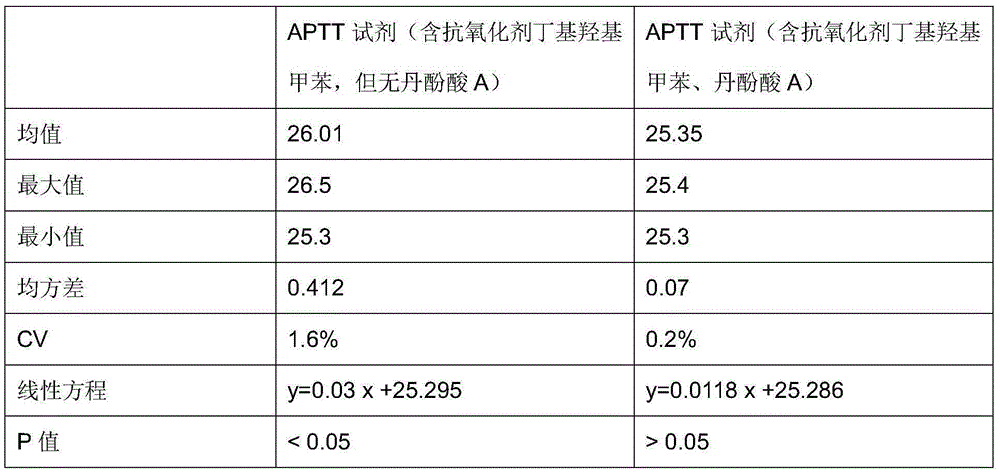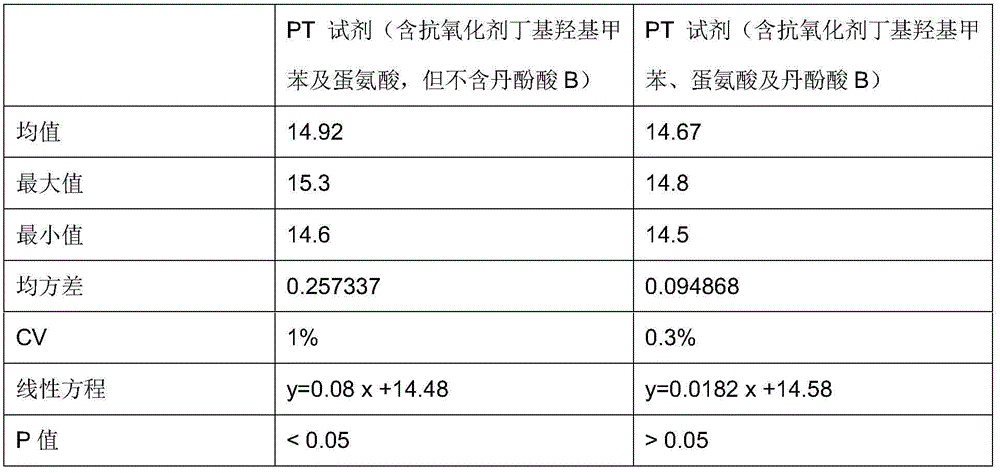Antioxidant for coagulative reagent
A technology of antioxidants and reagents, applied in biological testing, material inspection products, etc., can solve problems such as unfavorable safety production, phenol impact, etc.
- Summary
- Abstract
- Description
- Claims
- Application Information
AI Technical Summary
Problems solved by technology
Method used
Image
Examples
Embodiment 1
[0037] Effect of Salvianolic Acid A on the Antioxidant Activity of APTT Reagent
[0038] (1) Reagent oxidation resistance test at room temperature
[0039] Preparation of APTT reagent: Take mixed phospholipids (PS of 20 μmol, PC of 35 μmol and PE of 35 μmol), join in 50mL concentration and be the HEPES buffer solution of 25mmol / L, the sodium azide of 0.05% is contained in the HEPES buffer solution, 100mM Sodium chloride and 20mg / L of butylated hydroxytoluene, the pH is 7.4. Add bovine serum albumin, 40nm silicon dioxide, mannitol and maltose to the mixed solution, make up the filtrate to a volume of 1L with deionized water, so that the composition and content of each part in the final solution are: 0.07mmol mixed Phospholipids, 3g silicon dioxide, 0.7g butylated hydroxytoluene, 25g mannitol, 20g maltose, 5g bovine serum albumin, 30g sodium chloride and 0.1g sodium azide. After the above mixed solution is uniformly mixed by a magnetic stirrer, it is filtered with a 0.22 micro...
Embodiment 2
[0053] Effects of Salvianolic Acid B on the Antioxidation of PT Reagents
[0054] (1) Reagent oxidation resistance test at room temperature
[0055] Preparation of PT reagent: Take mixed phospholipids (PS of 20 μmol, PC of 35 μmol and PE of 35 μmol), join in 50mL concentration and be 25mmol / L in the HEPES buffer solution, the sodium azide of 0.05% is contained in the HEPES buffer solution, 100mM Sodium chloride and 20mg / L of butylated hydroxytoluene, the pH is 7.4. Pour the buffer solution into 1L burnout, add 10g TritonX-100, and stir gently at 25°C for 90 minutes to obtain a uniformly dispersed phospholipid solution. Add rabbit brain tissue factor, bovine serum albumin, methionine, sodium chloride, PEG, mannitol, maltose, and sodium azide to the above solution containing phospholipids, and set the volume to 1 L, so that the volume of each component in the final solution The content is: rabbit brain tissue factor 300nm, mixed phospholipids 2.5mM, bovine serum albumin 0.1%, ...
Embodiment 3
[0069] Effect of Rosmarinic Acid on the Antioxidant Activity of TT Reagent
[0070] (1) Reagent oxidation resistance test at room temperature
[0071] Prepare a buffer solution with a Tris concentration of 50 mM (pH7.4), and add a final concentration of 2% BSA, 0.05% sodium azide, 3.5% methionine, 1.5% PEG, 3% Mannitol, 2.5% maltose, and 10 mM calcium chloride, all of which except calcium chloride are mass volume fractions. The above mixed solution was filtered with a 0.22 micron filter membrane, and a freeze-dried preparation of human thrombin was added to the filtrate so that the concentration of human thrombin in the final filtrate was 25 U / ml to obtain TT reagent. The TT value of the reagent was determined by CA1500 coagulation analyzer to be 15.8s.
[0072] Contrast reagents: Studies have shown that in the blood coagulation preparations containing thrombin, the addition of high concentrations of salvianolic acid and rosmarinic acid not only did not play an antioxidant r...
PUM
 Login to View More
Login to View More Abstract
Description
Claims
Application Information
 Login to View More
Login to View More - R&D
- Intellectual Property
- Life Sciences
- Materials
- Tech Scout
- Unparalleled Data Quality
- Higher Quality Content
- 60% Fewer Hallucinations
Browse by: Latest US Patents, China's latest patents, Technical Efficacy Thesaurus, Application Domain, Technology Topic, Popular Technical Reports.
© 2025 PatSnap. All rights reserved.Legal|Privacy policy|Modern Slavery Act Transparency Statement|Sitemap|About US| Contact US: help@patsnap.com



